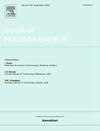Oscillatory heat transfer analysis of assisting and opposing radiating flow of Williamson-nanofluid along heat-exchanger plate in nuclear-power reactors: numerical simulation
IF 2.3
3区 工程技术
Q1 NUCLEAR SCIENCE & TECHNOLOGY
引用次数: 0
Abstract
Exothermic catalytic chemical reaction and thermal solar energy aspects for steady and fluctuating heat and mass flow rate using Williamson nanofluid is very important in nuclear power reactors. Main purpose of this work is to analyze viscous dissipation effects for fluid temperature field, concentration reactants, stead and oscillatory heat-mass transport, streamlines and isotherms along heat exchanger plate of nuclear power reactor using opposing and assisting flow. Significance of this study is to display oscillations and periodical heat transfer and skin friction using opposing and assisting flow. Mathematical formulation is developed for the computational assessment of laminar stream rate and fluctuating heat-mass transmission by using amplitude and phase change analysis. For programming algorithm and numerical results, the mathematical model is solved by dimensionless variables, Stokes oscillating factors, primitive transformations, implicit finite-difference methodology, and Gaussian elimination computation. For numerical results, the following range of parameters exothermic reaction rate , Eckert number , radiation , Prandtl 0.1 Pr 10.0, local-modified buoyancy forces , Schmidt number , thermophoresis , Brownian motion , Weissenberg number , and activation energy are considered. First steady flow rate is calculated and used in fluctuating formula to examine oscillatory flow rate. The percentage rate (28 %) of heat transfer is increased at small choice of Eckert number = 0.1. The maximum percentage (16 %) of mass rate is observed at high Eckert number = 2.0. It is observed that streamlines contour increases as radiation-energy increases and exothermic/catalytic reaction flow decreases. It is deduced that level of isotherms contour is increased as exothermic/catalytic reaction and Weissenberg number increases. Significant increase in steady friction rate, heat flux and mass flux is noticed as exothermic/catalytic reaction flow increases. Oscillating amplitude and turbulent rate in heat flux and mass flux is improved as exothermic catalytic reaction and Weissenberg number rises.
核动力反应堆热交换板上威廉逊纳米流体助反辐射流动的振荡换热分析:数值模拟
利用Williamson纳米流体进行放热催化化学反应和热太阳能方面的稳态和波动热和质量流量在核电反应堆中具有重要意义。本文的主要目的是分析核动力反应堆换热器板上的流体温度场、反应物浓度、稳态和振荡热质输运、流线和等温线在反流和助流条件下的粘滞耗散效应。本研究的意义在于利用反向流动和辅助流动来显示振荡和周期性的传热和皮肤摩擦。利用振幅和相变分析,建立了计算层流速率和波动热质传递的数学公式。在编程算法和数值结果方面,采用无因次变量、斯托克斯振荡因子、原始变换、隐式有限差分法和高斯消去计算等方法求解数学模型。数值结果考虑放热反应速率0.1≤Cr≤2.0,Eckert数0.1≤Ec≤2.5,辐射0.1≤Rd≤6.0,Prandtl 0.1≤Pr≤10.0,局部修正浮力0.1≤λT,λC≤4.0,Schmidt数0.1≤Sc≤1.5,热游0.1≤NT≤0.8,布朗运动0.1≤NB≤0.6,Weissenberg数0.1≤W≤2.5,活化能0.1≤EA≤1.5等参数范围。首先计算定常流量,用波动公式计算振荡流量。当埃克特数(Eckert number) = 0.1时,传热百分率(28%)增加。在高埃克特数(Eckert number) (ec = 2.0)时,观察到质量率的最大百分比(16%)。随着辐射能量的增加和放热/催化反应流量的减小,流线轮廓增大。推导出随着放热/催化反应和Weissenberg数的增加,等温线等高线水平增加。随着放热/催化反应流量的增加,稳定摩擦率、热通量和质量通量显著增加。随着放热催化反应的增加和Weissenberg数的增加,热流通量和质量通量的振荡幅度和湍流速率都有所提高。
本文章由计算机程序翻译,如有差异,请以英文原文为准。
求助全文
约1分钟内获得全文
求助全文
来源期刊

Annals of Nuclear Energy
工程技术-核科学技术
CiteScore
4.30
自引率
21.10%
发文量
632
审稿时长
7.3 months
期刊介绍:
Annals of Nuclear Energy provides an international medium for the communication of original research, ideas and developments in all areas of the field of nuclear energy science and technology. Its scope embraces nuclear fuel reserves, fuel cycles and cost, materials, processing, system and component technology (fission only), design and optimization, direct conversion of nuclear energy sources, environmental control, reactor physics, heat transfer and fluid dynamics, structural analysis, fuel management, future developments, nuclear fuel and safety, nuclear aerosol, neutron physics, computer technology (both software and hardware), risk assessment, radioactive waste disposal and reactor thermal hydraulics. Papers submitted to Annals need to demonstrate a clear link to nuclear power generation/nuclear engineering. Papers which deal with pure nuclear physics, pure health physics, imaging, or attenuation and shielding properties of concretes and various geological materials are not within the scope of the journal. Also, papers that deal with policy or economics are not within the scope of the journal.
 求助内容:
求助内容: 应助结果提醒方式:
应助结果提醒方式:


